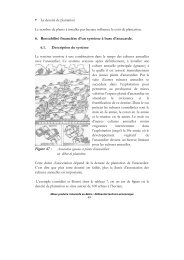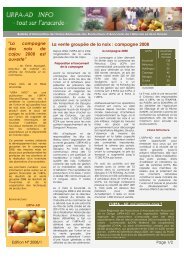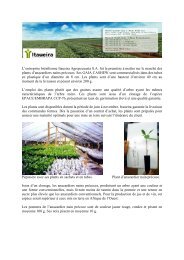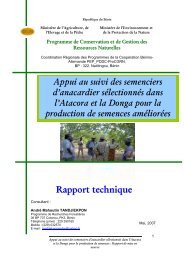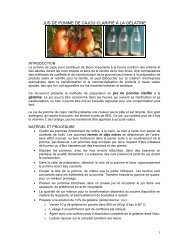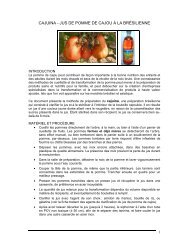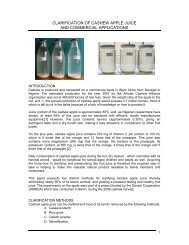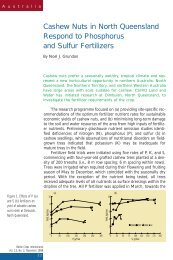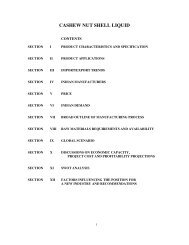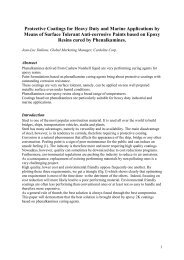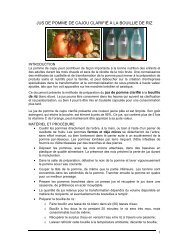Novel Separation Processes Multiphase Reactor CHEMCON â 05 ...
Novel Separation Processes Multiphase Reactor CHEMCON â 05 ...
Novel Separation Processes Multiphase Reactor CHEMCON â 05 ...
You also want an ePaper? Increase the reach of your titles
YUMPU automatically turns print PDFs into web optimized ePapers that Google loves.
<strong>CHEMCON</strong> – <strong>05</strong>, New Delhi<br />
Session: <strong>Novel</strong> <strong>Separation</strong> <strong>Processes</strong><br />
<strong>Multiphase</strong> <strong>Reactor</strong><br />
Selective Extraction of Cardanol and Phenols from Cashew Nut<br />
Shell Liquid Obtained Through Pyrolysis of Cashew Nut Shells<br />
Rajesh N. Patel a , Santanu Bandyopadhyay b , Anuradda Ganesh c*<br />
a Energy Systems Engineering, Indian Institute of Technology Bombay, Powai, Mumbai- 400 076<br />
and Nirma Institute of Technology, Ahmedabad- 382 481, India, E mail: rnp@me.iitb.ac.in<br />
b Energy Systems Engineering, Indian Institute of Technology Bombay, Powai, Mumbai- 400 076,<br />
India, E mail: santanu@me.iitb.ac.in<br />
c Energy Systems Engineering, Indian Institute of Technology Bombay, Powai, Mumbai- 400 076,<br />
India, E mail:aganesh@me.iitb.ac.in<br />
Keywords: Cashew nut shell liquid, Phenol, and Supercritical fluid extraction.<br />
ABSTRACT<br />
The feasibility of extraction of phenol rich oil from the cashewnut shell liquid obtained<br />
through pyrolysis of cashew nut shells has been studied. The oil samples obtained at various<br />
operating parameters have been analysed by Gas Chromatograph Mass Spectroscopy (GC-<br />
MS) and Fourier Transform Infra-Red Spectroscopy (FTIR). The operating parameters were<br />
optimised for maximum concentration of phenol and cardanol. The kinetics of the extraction<br />
of CNSL using CO 2 as a supercritical fluid has been studied. Higher yield of oil (50% by<br />
weight) along with higher concentration of phenols and cardanol by present method is found<br />
encouraging.<br />
INTRODUCTION<br />
Bio-oil, obtained through vacuum pyrolysis, is typically dark brown in colour with a<br />
distinctive pungent smell. This liquid contains several chemicals in different proportions. The<br />
applications of bio-oil are well reported in the literature (Bridgewater and Peacocke, 1995).<br />
One such application is the recovery of chemicals such as phenols, resin, agri-chemicals,<br />
fertilizers and emission control agents. On an average pyrolysis liquid obtained through<br />
various biomass contains about 10 to 20% water, 15-30% lignin fragments, 10-20%<br />
aldehydes, 10-15% carboxylic acids, 5 to 10% carbohydrates, 2-5% phenols and traces of<br />
furfurals, alcohols and ketones (Radlein, 1999). This in-situ natural phenol can be used for<br />
resin preparations. However, the presence of carboxylic acid puts a limit on direct use of biooils<br />
for such applications. Cashewnut shells and sugarcane bagasse, upon pyrolysis, give<br />
phenol rich oil along with other chemical components (Das, 2004). The selective separation<br />
of phenols and substituted phenols has been demonstrated using SCFE in subsequent<br />
sections.<br />
The most significant products from phenol are phenolic resins, which are used as a raw<br />
material for laminate industries and manufacturing of special chemicals. The annual demand<br />
of phenol is more than 120000 tonnes in Indian context and it increases at the rate of 8% p.a.<br />
(www.dsir.nic.in/reports/techreps/tsr120.pdf). The raw materials for phenol manufacturing<br />
are benzene and propylene. There is likely to be a shortage of both benzene and propylene in<br />
local market. Moreover, the chemical process of manufacturing phenol ends up with large
amount of waste-water containing significant amount of phenols which is of environment<br />
concern. Hence, there is a strong requirement for an alternative, which can reduce the<br />
consumption of petro-based phenols and also be environment friendly. Within ten years<br />
DuPont hopes to derive 25% of its chemicals from renewable sources, and the prestigious US<br />
National Research Council predicts 50% of US fuels and over 90% of US organic chemicals<br />
will come from renewable sources by the end of century<br />
(www.bioalberta.com/ims/client/upload.doc). Natural phenols can be extracted from the<br />
Cashew nut shell liquid along with char as the by-product.<br />
India is the largest producer, processor and exporter of cashew in the world. In India cashew<br />
cultivation covers a total area of about 0.77 million hectares of land, with annual production<br />
over 0.5 million metric tonnes of raw cashew nuts. Cashew nut shell liquid (CNSL) is the byproduct<br />
of the cashew industry. Conventionally, CNSL is extracted by various methods such<br />
as open pan roasting; drum roasting, hot oil roasting, cold extrusion, etc. A new method of<br />
extraction using vacuum pyrolysis has been suggested by Das et al. (2004). This study<br />
explores the use of SCFE for selective extraction of cardanol and phenols, in particular from<br />
the CNSL, making this oil an attractive commercial product. This study illustrates the new<br />
methodology for CNSL extraction by supercritical fluid extraction (SCFE) route. The CNSL<br />
extracted through this method contains higher concentration of cardanol and significant<br />
concentration of phenols.<br />
Supercritical carbon dioxide (SC-CO 2 ) extraction of phenols eliminates the use of hazardous<br />
solvents. SC-CO 2 is extremely 'green' solvents since by reducing the pressure it is returned to<br />
their former gaseous state and can be readily separated from the product and recycled. The<br />
residue leftover after phenol extraction can be used as a fuel.<br />
METHODS AND MATERIAL<br />
Cashew nut shells (CNS) were sun dried for few days immediately after harvest to have low<br />
moisture content between 8 to 10%. Then, they are shelled and kernels are removed. These<br />
shells were used as a feed material in the pyrolysis reactor.<br />
EXPERIMENTAL PROGRAMME<br />
Pyrolysis<br />
The pyrolysis of the cashew nut shells was carried out in the pyrolysis reactor. About 150<br />
gram of the sample was placed in a reactor. The pyrolysis of these samples was carried out at<br />
a vacuum of 720 mm of Hg and at a temperature of 773 K as suggested by Subbarayudu<br />
(2003). The volatiles were condensed in the condensing train consisting of five glass bottles.<br />
The volatiles condensed in first two bottles of the condensing train were collected for the<br />
further study. The rest of three bottles consisted of aqueous fraction.<br />
Supercritical fluid extraction of Pyrolysis oil<br />
The cashew nut shell liquid collected through pyrolysis reactor was used as a feed material.<br />
About 100 gram of pyrolysis oil was kept in the extractor of SCFE experimental set-up with<br />
all connections and fittings made of 316 stainless steel. Carbon dioxide from the cylinder<br />
passes through a pre-cooler, a positive displacement pump, and a pre-heater before it enters<br />
the bottom of the extraction vessel. (The extraction vessel is maintained at a predefined<br />
temperature). The flow of carbon dioxide is controlled by a needle valve and is measured by
a gas flow meter with an accuracy of ±0.01 kg/h. A variable frequency drive pump controls<br />
the pressure in the vessel to an accuracy of ± 0.1 bar. Extracted oil is recovered by<br />
expansion of the loaded solvent stream to ambient pressure in a glass separator. Extract is<br />
collected at a fixed time interval of 30 minutes (cumulatively) by closing the needle valve.<br />
This extract is then weighed. The needle valve is then opened and extraction process<br />
continues for the next interval. Runs have been carried out for six hours at pressure ranging<br />
from 120-300 bar. The experimental procedure is explained in detail elsewhere (Patel et al.,<br />
20<strong>05</strong>). The extract of each run is analysed by GC-MS and FTIR.<br />
Chemical Characterisation<br />
The fractions of CNSL obtained at different operating parameters of SCFE have been<br />
analysed by GC/MS and FT-IR. The GC/MS analysis was done using a Hewlett Packard<br />
5890 A. GC/MS system with a 30 m × 0.25 mm ID- capillary column coated with<br />
polysiloxane. The initial oven temperature of GC was kept at 100 o C for two minutes and then<br />
programmed to increase at a rate of 10 o C/min to 250 o C. Afterwards, it was increased at a rate<br />
of 30 o C/min up to 280 o C. Helium was used as a carrier gas with a flow rate of 0.7 ml/min.<br />
The ratio of mass to charge (m/z) was used to identify the most probable fragments of the<br />
components elucidated. The percentage area of the peak identified by GC gave the relative<br />
concentration of the components present in the given fractions.<br />
Results and Discussion<br />
Table 1 gives the comparison of the components present in CNSL extracted through SCFE<br />
route from three different sources. Second column of Table 1 indicates components present in<br />
super critically extracted CNSL (SC CNSL) obtained from ground cashew nut shells (CNS).<br />
Here, CNS were ground to a uniform size and fed in to the extractor. SC-CNSL was obtained<br />
at different operating parameters from CNS.<br />
Third column of Table 1 gives the components found in SC CNSL extracted through SCFE<br />
of cashew nut shell oil obtained by heating CNS in the heat exchanger. In this process, CNS<br />
were placed in the heat exchanger where they were heated up to 180 0 C. At this temperature,<br />
CNSL started oozing out from CNS and oil was collected. This CNSL was used as a feed in<br />
SCFE. SC CNSL was then extracted at different operating parameters.<br />
Last column of Table 1 indicates the components present in SC CNSL extracted from CNSL<br />
obtained through pyrolysis route. It is observed from Table 1 that the SC CNSL directly<br />
obtained from CNS contains traces of acids whereas the same obtained from CNSL through<br />
heat exchanger mainly contains cardanol along with acids and alkanes. The interesting point<br />
about the composition in SC CNSL extracted from CNSL obtained through pyrolysis of CNS<br />
is that, along with cardanol, oil contains phenols and substituted phenols. These phenols were<br />
not found in oil obtained through the other two sources. Moreover oil obtained by this<br />
method was free from acids and alkanes. Therefore, for resin making the CNSL obtained<br />
through pyrolysis route is the most suitable feed for extraction SC CNSL.<br />
Table 2 shows the identified components in SC-CNSL from thermally obtained (through<br />
pyrolysis process) CNSL at different operating parameters. It can be seen that the<br />
concentration of lighter molecular weight components is higher at lower operating pressures,<br />
while the concentration of higher molecular weight components increases with increase in<br />
pressure. The solubility of SCF for cardanol increases with increase in pressure, and hence,<br />
the area percentage for the cardanol peak indicated by GC increases from 26% at 145 bar to<br />
84% at 300 bar. Removing other components at lower operating pressures and then
subsequently increasing the pressure to 300 bar can extract the cardanol rich oil. The<br />
fractionasation of CNSL obtained through pyrolysis was studied by Das et al. (2004). They<br />
reported that the CNSL consists of cardanol, cardol, Di-n-octyl phthalate, Bis-(2,ethylhexyl)-<br />
Phthalate and Di-n-decyl phthalate as the major components with low concentrations of<br />
substituted phenols. This study shows that the fractions consist of cardanol as a major<br />
component along with lower concentrations of substituted phenols. The higher molecular<br />
weight components like different groups of phthalates have not been extracted and they<br />
remain in residue only. The cardanol and substituted phenols, so extracted, may be used as<br />
natural phenols for making phenol-formaldehyde resins, which is a raw material for industrial<br />
laminates. GC-MS analysis again shows that the concentration of natural phenols along with<br />
cardanol is maximum in supercritically extracted CNSL obtained through pyrolysis route.<br />
The FT-IR spectra for all the fractions show a broad absorbance peak of O-H stretching<br />
between 3600 and 3<strong>05</strong>0 cm -1 , indicating the presence of phenols in CNSL.<br />
Extraction kinetics for CNSL at different operating pressure with operating temperature of<br />
50 o C and mass flow rate of solvent 1.2 kg/h is shown in Figure 1. The batch time was taken<br />
as 150 minutes. It can be observed that the rate of extraction varies significantly with<br />
extraction pressure. The increase in yield of CNSL to the tune of 50% was observed with<br />
increase in pressure from 225 to 300 bar, keeping other operating parameters constant. It was<br />
also interesting to note from GC-MS results that the total concentration of phenols and<br />
cardanol has also increased with increase in pressure.<br />
60<br />
50<br />
Yield (%)<br />
40<br />
30<br />
20<br />
10<br />
0<br />
0 25 50 75 100 125 150<br />
Time (min)<br />
225 bar<br />
250 bar<br />
300 bar<br />
Figure 1- Extraction of CNSL at different operating pressures
Table 1 Chemical characterisation of CNSL extracted by SCFE<br />
Operating SC-CNSL from CNS<br />
Parameter<br />
(P bar/ T o C)<br />
200/60 Hexadecanoic acid (0.71)<br />
Oleic acid (0.62)<br />
Cardanol-C13 (0.69)<br />
Cardanol C15 (84.20)<br />
Methyl Cardanol (2.83)<br />
225/60 Hexadecanoic acid (0.56)<br />
Oleic acid (0.84)<br />
Cardanol-C13 (0.65)<br />
Cardanol C15 (86.26)<br />
Methyl Cardanol (3.11)<br />
250/60 Diethyl Phthalate (12.34)<br />
Hexadecanoic acid (0.58)<br />
Cardanol-C13 (7.42)<br />
Cardanol C15 (64.89)<br />
Methyl Cardanol (3.03)<br />
300/60 Hexadecanoic acid (0.80),<br />
Oleic acid (0.67),<br />
Cardanol-C 13(2.32),<br />
Cardanol-C15 (61.34),<br />
Cardanol -C17 (2.06),<br />
Diethyl phthalate (13.35)<br />
SC-CNSL from CNSL obtained<br />
through Heat exchanger unit<br />
Pentadecane (0.67)<br />
Hexadecane (0.67)<br />
Heptadecane (0.77)<br />
2,6,10,14 tetramethyl pentadecane<br />
(0.65)<br />
8 methyl Heptadecane (0.70)<br />
Hexadecanoic acid (0.61)<br />
Eicosane (0.47)<br />
Cardanol (62.31)<br />
Cardanol diene (31.24)<br />
Pentadecane (0.04)<br />
Heptadecane (0.08)<br />
tetradecenal (1.99)<br />
Cardanol-C13 (0.1.62)<br />
Hexadecanoic acid (1.27)<br />
Cardanol (81.54)<br />
2 Methyl Cardanol diene (5.28)<br />
Hexadecanoic acid (1.01)<br />
Oleic acid (0.98)<br />
Cardanol diene (81.94)<br />
2 Methyl Cardanol diene (2.97)<br />
-<br />
SC-CNSL from<br />
pyrolysis CNSL<br />
3 – ethyl phenol (7.64)<br />
2- methyl benzaldehyde<br />
(20.51)<br />
3- butyl phenol (1.39)<br />
Cardanol diene (48.61)<br />
3- ethyl phenol (3.31)<br />
Azulene (1.89)<br />
Ethenyloxy Benzene<br />
(11.21)<br />
Acenaphthylene (7.12)<br />
3- butyl phenol (2.28)<br />
Cardanol (66.82)<br />
4- ethyl phenol (5.01)<br />
propyl Benzene (11.96)<br />
Acenaphthylene (2.83)<br />
3- Pentyl plenol (3.18)<br />
3- butyl phenol (1.35)<br />
Cardanol (64.90)<br />
2- ethyl phenol (4.89)<br />
2- methyl benzaldehyde<br />
(8.73)<br />
Cardanol (80.50)
Table 2. Identification of components in SC-CNSL obtained from pyrolysis CNSL at<br />
different operating parameters using GC-MS<br />
Operating Parameters Retention Time (GC-<br />
(P bar/ T o C)<br />
spectra)<br />
145/40 3.46<br />
3.75<br />
4.96<br />
5.79<br />
6.41<br />
16.04<br />
16.15<br />
175/40 3.41<br />
3.74<br />
3.77<br />
6.41<br />
16.03<br />
16.35<br />
200/40 3.40<br />
3.77<br />
6.39<br />
7.51<br />
8.74<br />
16.02<br />
16.35<br />
225/40 3.45<br />
3.82<br />
6.42<br />
7.61<br />
8.76<br />
16.03<br />
16.35<br />
250/40 3.40<br />
3.78<br />
6.40<br />
6.47<br />
7.52<br />
7.61<br />
16.01<br />
16.35<br />
300/40 3.41<br />
3.78<br />
6.40<br />
16.01<br />
16.35<br />
Identified<br />
Components<br />
2-ethyl phenol<br />
Azulene<br />
2-methyl Naphthalene<br />
Cyclododecene<br />
Acenaphthylene<br />
Cardanol (diene)<br />
Cardanol (triene)<br />
4-ethyl phenol<br />
Naphthalene<br />
Ethenyloxy-Benzene<br />
Acenaphthylene<br />
Cardanol (diene)<br />
Cardanol (triene)<br />
3-ethyl phenol<br />
Ethenyloxy-Benzene<br />
Acenaphthylene<br />
3-butyl-Phenol<br />
3-octyl-Phenol<br />
Cardanol (diene)<br />
Cardanol (triene)<br />
3-ethyl phenol<br />
Ethenyloxy-Benzene<br />
Acenaphthylene<br />
3-butyl-Phenol<br />
3-octyl-Phenol<br />
Cardanol (diene)<br />
Cardanol (triene)<br />
4-ethyl phenol<br />
Ethenyloxy-Benzene<br />
Acenaphthylene<br />
3-pentyl-Phenol<br />
3-butyl-Phenol<br />
3-octyl-Phenol<br />
Cardanol (diene)<br />
Cardanol (triene)<br />
2-ethyl phenol<br />
Ethenyloxy-Benzene<br />
Acenaphthylene<br />
Cardanol (diene)<br />
Cardanol (triene)<br />
% Area of identified<br />
peak in GC spectra<br />
9.19<br />
39.83<br />
5.57<br />
5.75<br />
6.88<br />
23.32<br />
3.25<br />
10.07<br />
11.74<br />
16.31<br />
7.65<br />
47.<strong>05</strong><br />
2.69<br />
7.64<br />
20.51<br />
9.65<br />
1.39<br />
2.60<br />
43.32<br />
7.58<br />
3.31<br />
11.21<br />
7.12<br />
4.15<br />
2.28<br />
58.58<br />
8.24<br />
5.01<br />
11.96<br />
2.83<br />
3.18<br />
1.35<br />
2.80<br />
57.33<br />
7.57<br />
4.89<br />
8.73<br />
0.09<br />
76.90<br />
8.69
CONCLUSIONS<br />
The present methodology optimises the operating parameters for the extraction of phenol rich<br />
CNSL.The optimised pressure and temperature was 300 bar and 333 K respectively. The<br />
present study explores the possibility of extraction of natural phenols, which reduces the<br />
dependency of petro-based phenols. The oil obtained by this method was found more stable<br />
and less viscous as compared to the same obtained through pyrolysis process.<br />
REFERENCES<br />
Bridgewater T., Peacocke C., 1995, Biomass fast pyrolysis. In Proceedings of Second<br />
Biomass Conference of The Americas – Energy, Environment, Agriculture and Industry.,<br />
Portland. 1037.<br />
Das P., 2004, Studies on pyrolysis of sugarcane bagasse and cashew nut shell for liquid fuels,<br />
Ph.D. Thesis, Indian Institute of Technology, Bombay, India.<br />
Das, P., Ganesh, A., 2003, Bio-oil from pyrolysis of cashew nut shell—a near fuel, Biomass<br />
and Bioenergy, 27(5), 113-117.<br />
Das, P., Sreelatha, T., Ganesh, A., 2004, Bio oil from pyrolysis of cashew nut shellcharacterisation<br />
and related properties, Biomass and Bioenergy, 27(5), 265-275.<br />
Patel, R. N., Bandyopadhyay, S., Ganesh, A., 20<strong>05</strong>, Extraction of cashew (Anacardium<br />
occidentale) nut shell liquid using supercritical carbon dioxide, Bioresource Technology, In<br />
Press, Available online 6 June 20<strong>05</strong><br />
Radlein D., 1999, The production of chemicals from fast pyrolysis bio-oils, In: Bridgewater<br />
A., Fast Pyrolysis of Biomass. CPL Press.<br />
Subbarayudu, K., 2003, Thermochemical conversion for pyrolysis liquids. Ph.D. dissertation;<br />
Indian Institute of Technology, Bombay, India.<br />
www.bioalberta.com/ims/client/upload/developingbiobasedindustriesincanada.doc.<br />
visited August 16, 20<strong>05</strong>.<br />
Date<br />
www.dsir.nic.in/reports/techreps/tsr120.pdf date visited August 16, 20<strong>05</strong>.





